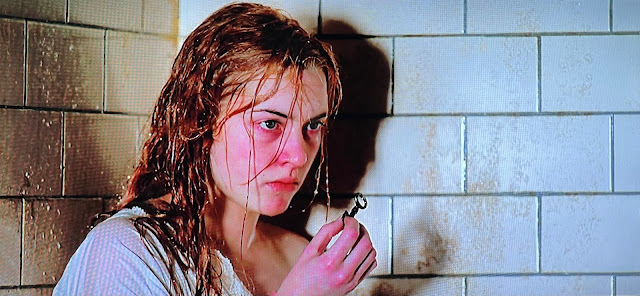K - “Key”
“It’s in my memory lock’d, / And you yourself shall keep the key of it,” Ophelia promises to Laertes regarding his brotherly advice touching upon Hamlet. She is the only character in the play to use the word “key,” and later in the film, in a crystalline moment of prescience, Kate Winslet furtively produces a literal key from her mouth.
Guildenstern is bemused by Hamlet’s reference to Denmark as a prison, and the Prince may believe it so, but “Denmark”—a metonym for the King and monarchy in general—is more a prison for the women than anyone else. The Player Queen, on one hand, almost cheerfully compares her marriage to her King as a detention of the heart, and if she should betray him by marrying again after his death, she promises “an anchor’s cheer in prison be my scope” (3.2.155). In Grigori Kosintsev’s film, a bereft Ophelia dons a literal metal cage of a mourning dress—a stark image illustrating the emotional and mental confinement she must endure as the object and pawn of courtly politics and intrigue.
Asta Nielsen doubles down on the prison metaphor in her silent film Hamlet: The Drama of Vengeance (1921) by not only playing Hamlet herself, but altering the facts of the plot: Gertrude gives birth to a daughter, and thinking Old Hamlet slain in battle, lies to the court and the commonwealth, announcing the arrival of Prince Hamlet. When the King returns to the castle, very much alive, they conspire to perpetuate the lie, and raise their daughter to pose as a son. When she grows and goes to Wittenberg, she is trusted to conceal her true sex, but she soon falls in love with Horatio, and privately laments her inability to act upon her feelings. She becomes a captive of her assumed gender and her parents’ lie, and upon learning of Gertrude and Claudius’ conspiracy to kill her father, she is also made hostage by her desire for revenge.
Branagh’s film evokes Ophelia’s incarceration most intentionally by clothing her in a strait jacket and providing a padded room where she is shown mindlessly bouncing off the walls. After Ophelia sings her last, she calmly walks away from Laertes and willingly enters the padded room, standing right up against one wall, staring into it with a disquieting stone-still silence—retreating to the “soft prison” of her female status in a world run by men.
When Horatio later goes to check on Ophelia, he goes to a door and slides open an iris-like aperture—much like that of a camera’s—to see her scantily clad and being sprayed with a high-pressure hose. This peep-show shot with obvious sexual overtones illustrates Laura Mulvey’s psychoanalysis of cinema as presenting the “male gaze” that delivers a scopophilic pleasure for an audience. Ophelia is one in a long line of females on film who have been trapped by the burden of objectification.
It seems the harsh water itself generates both the physical and the mental key to Ophelia’s only true escape: a watery grave.
Sources:
Bogaev, Barbara, Interviewer. “Pamela Hutchinson on Asta Nielsen’s Hamlet, ” Shakespeare Unlimited, Episode 188, Folger Shakespeare Library, 4/8/22. Link
Mulvey, Laura. “Visual Pleasure and Narrative Cinema.” Film Theory and Criticism, edited by Leo Braudy and Marshall Cohen, Oxford University Press, 1999, pp. 833-844




Comments
Post a Comment